| Please access the following URL if you want to secure using SSL. All pages in the site will be secure pages. |
| https://secure02.blue.shared-server.net/www.fish-food.co.jp/message english 5.2019.html |
Welcome to FISH FOOD TIMES
May. 2019 issue No.185

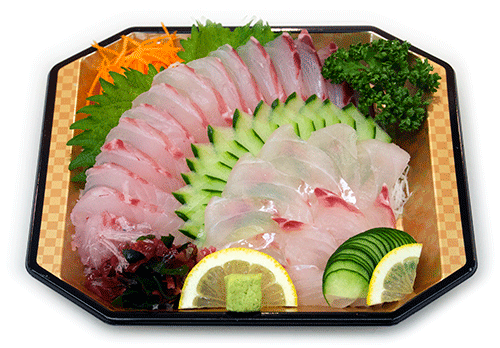
Blue fusilie sashimi
Luxury fish with strong regionality in the south of Japan
Blue fusilier is called Hota in Kagoshima and the Amami Islands, Shityumachi in Okinawa, and Aoze in Hachijojima and Izu Islands. In the southern part of Japan, which is mainly caught, it shows its presence as a high-class white fish, but in other areas it is a very regional fish that is hardly known at all. The spawning season of blue fusilier is the summer season mainly from July to August, and it can be said that the best season in a year is around May before egg laying.
This fish is suzuki class, suzuki order, suzuki suborder, snapper order, blue fusilier geneus, blue fusilier, and the snapper order is divided into sparrow genus, lavender jobfish genus, blue fusilier genus etc., and there are about 30 kinds of relatives and brothers.
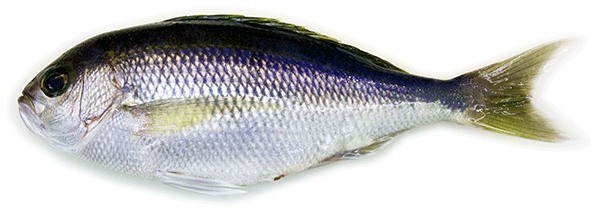
InTokyo, where blue fusiliers caught in Hachijojima, which is a part of Tokyo, are often sent, they are prized as high-quality white fish, and they are fish that can be used in a variety of dishes without any peculiarities. For this reason, sushi restaurants and high-class Japanese restaurants are mainly purchased, and it seems that there is hardly any place in the city's super fish market. However, this is not the case in supermarkets in the Nansei Islands and Okinawa, and it is not uncommon to see scenes where blue fusilier with round fish and its sashimi and fillets are displayed in the fish market.
The purchase price of blue fusilier, which is called shityumachi in Okinawa, is not necessarily as high as that in Tokyo. However, blue fusilier is almost no mistake if it is treated as a high quality fish that comes next to Akamachi (Longtailed red snapper), Akajin (Red-spotted rockcod), and Makubu (Blackspot tuskfish).
Fish's subcutaneous fat and taste
There are many kinds of fish named Machi in Okinawa, but if you say representative machi in descending order of market price, No. 1 is akamachi (longtailed red snapper), second is shicyumachi (blue fusilier), and the third Is in the order of kurukinmachi (lavender jobfish), but the size is also exactly in this order, longtailed red snapper is often too large, lavender jobfish is often relatively small, and in other words the middle blue fusilier is the most convenient size.
For example, it is possible to commercialize figure sashimi in one fish, such as the following image, by utilizing its convenient size.
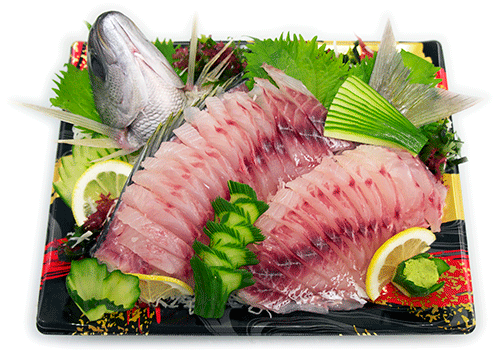
| Blue fusilier figure sashimi |
|---|
First page image of this issue is the commercialization of sashimi using the half body of blue fusilier, but if you use 1 fish in this way and use figure sashimi that also uses a lot of as such, it looks better and has volume. , It will be more valuable than half-bodied products.
The first page image half sashimi is divided into a back body and a belly body to make a sashimi, but the figure sashimi in the above image shows a big difference in appearance by removing a small bone and making a hiratsukuri sashimi a half body. The difference is not divided into the back body and belly body as in the first page image, but since it is half-body in hiratsukuri sashimi, the part of the red chiai meat stands out vividly, and its beauty is increasing.
As a feature common to snapper order members including blue fusilier, longtailed red snapper and lavender jobfish are also mentioned as "a bright chiai meat of fish color of white and a good contrast".
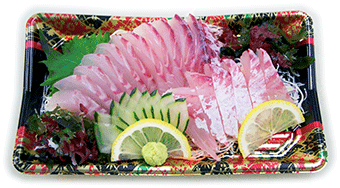

| Longtailed red snapper hiratsukuri sashimi | Lavender jobfish figure sashimi |
|---|
The fish's chiai meat of fish in snapper order looks vivid, which is another evidence that there is not too much subcutaneous fat, and you should not expect the taste due to the abundance of fat like cultured fish It also means.
Not only fish but also meat, food fat leads to "food is delicious", I think that I understand if I remember blue fin tuna toro and Japanese beef sirloin. If that is the case, snapper order fish such as blue fusilier with low fat will not be delicious, but it is not blue fusilier is definitely delicious.
Blue fusilier does not harden even if it is cooked or baked, and since a good soup comes out of the bones, it becomes a delicious dish no matter what you cook. Of course there is not much fat compared to blue fin tuna, but it is delicious to eat raw with sashimi. Why is that?
What is delicious sashimi
How would you answer if you were asked what delicious sashimi is? Some people may mention the crispy texture of the live fish before rigor mortis, but from my experience, it is difficult to expect such a freshness level from blue fusilier.
In the first place, it may be understandable if the fish is fresh and you can not feel its taste if you know the relationship between inosinic acid that is the source of the fish taste and ATP that is the source of energy. Inosinic acid is produced by the decomposition of a substance called ATP that produces energy to move muscles, and it is regenerated as energy even if it is decomposed while the fish is alive. However, it is a well-known scientific fact that when the fish dies, the taste of the fish increases as the inosine acid increases with the degradation of ATP.
It is the muscle part of the fish that eats in sashimi, and the muscle is a structure bundled with many muscle fibers, and the muscle fibers are covered with a fibrous structure called connective tissue that maintains strength such as collagen. For example, comparing fish with red flesh such as tuna and white fish such as blue fusilier, fish with white flesh such as blue fusilier and flounder has more connective tissue and is a firm muscle, even if it is not a live fish sashimi to be hard to chew. On the other hand, fish with red flesh such as tuna and bonito have loose connective tissue of muscle fiber, there is a lot of fat in muscle, and the taste can be felt by the amount of fat.
Based on such knowledge, as the point of the sashimi technique, for example, in the case of bonito in the left image below, the muscle fiber is a loose red fish, and if the sashimi is cut thick using the hiratsukuri sashii technique, the soft body texture is covered It will be able to be eaten deliciously. On the other hand, the flounder in the lower right image has many muscle fibers and is hard and firm, so it is crunchy and delicious even when using the usutsukuri sashimi technique that cuts thinly in a transparent manner.
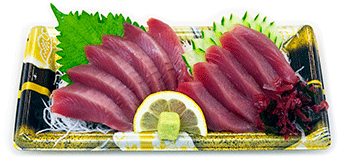
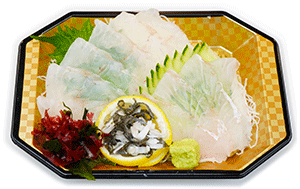
| Bonito hiratsukuri sashimi | Flounder usutsukuri sashimi |
|---|
When selling sashimi as a product, it is necessary to understand and create such various qualities of the fish meat, but there is a question as to how much this is understood to make sashimi in the modern super fish market . Customers who bought sashimi are said to be delicious, and in order to be satisfied, it is not only good to cut mechanically, it is not good to cut thinly by calculating the cost. We have to give priority to the quality of the fish meat, and as a result we must realize the value of the sashimi selling price in a technical way.
Products of sashimi have a premise to eat raw, freshness is particularly important for eating raw, and it is difficult to buy fresh fish at a cheap price, with the exception of large fishing etc. When it tries to realize, various unreasonableness arises. Rather than trying to realize sashimi at a low selling price, you should realize a sashimi of value that customers will think they want to buy again because they ate it delicious. For that purpose, you should make an effort to create and provide cost-effective sashimi by making good use of sashimi techniques and ashirai techniques for making them look delicious after understanding the quality of the fish meat.
A technique that makes sashimi look delicious
Japanese food was recognized as an intangible cultural heritage of UNESCO in 2013, but one of its features is "Respect for various fresh food and its taste". Sashimi, one of the central elements of Japanese food, is one of the characteristics of this feature, and there is no country other than Japan that uses fresh raw fish and has a refined form of food like sashimi.
In order to realize the refined sashimi, some trained kitchen knife technology is also required, one of which is the "ashirai technique", which uses and decorates vegetables other than fish. Below I would like to introduce some of the ashirai techniques that I sometimes do, but because they are presupposed to be commercialized at a fish market in a supermarket, they have the restriction that they can not take time-consuming and complex tasks, and they are relatively simple and It is only a technique that can be done in a short time.
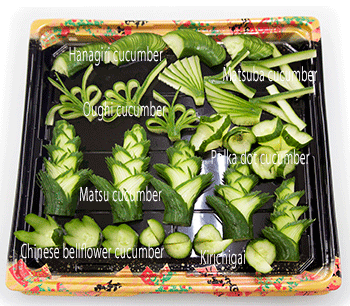
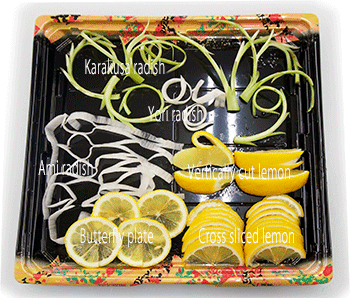
Blue fusilier's figure sashimi introduced above uses some of these techniques to decorate it. By this, I think that it can be agreed that the existence of these futures is increasing the commercial value.
Ashirai technique does not take much time to improve the skill if it is a dexterous person. However, when it comes to actually putting it in the product, the work efficiency will definitely go down because it will take plus alpha time as compared with no Ashirai. Therefore, a company that prioritizes work efficiency does not have to do such troublesome work, and there will be no "Ashirai with a knife" in sashimi. Instead, a simple dried seaweed to be returned to water, a parsley to be put on, and a factory-cut carrot ken will be attached with “Ashirai without using a kitchen knife”. As this is a simplification of Ashirai, and it can be done by any untrained unskilled person, technical differentiation from other companies will basically be difficult and will be exposed to price competition.
Japanese food has a basic idea of "five tastes five colors", and five senses are "sweet taste, sharp taste, acid taste, bitter taste, salty taste", and five colors are "red, blue (green), yellow, white, black. Even in sashimi, the idea is important, and it is possible to enhance the value by adding various colors and improving the appearance without stopping at monotonous colors.
The image below is a commercialized longtailed red snapper using the ashirai introduced above to the figure sashimi of the skin hot water frost and I think that the appearance becomes even more spectacular with the addition of various colors .
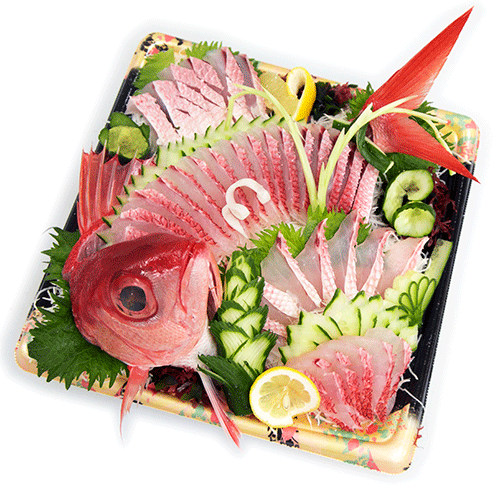
This product is not a figure sashimi that I made playfully for technical satisfaction, but a model that I presented as a model in technical training in a company's study and training. The trainees who participated in the training trained to do the same with reference to this model.
While there is a company that has many people who have acquired such technology, there is also a company with a system in which part-time workers make manual sashimi products without making any improvements. There are also companies where fish items are lined up with packed products, with sashimi being made intensively at the product center, with the top priority being that it will move and not collapse during transport. When comparing these companies, it will be clear which company will be the product that can increase customer satisfaction. It is not necessary to explain in particular the company that leads to the repeat customers that customers will "I would buy again because they look good and delicious."
Stores that are thriving in retail are "stores with many repeaters (stable customers)". On the other hand, a bargain shop with a floating visitor called a bargain hunter is immediately deprived of customers when a more bargain shop opens nearby. But unlike that, if a store with a wealth of people with high skills who can not easily copy even if other companies try to imitate, and continue to release attractive products, the stable customers of that store will be even if another new bargain store was created, it simply remained in place without leaving the store. In such stores, customers continue to increase even from a distance beyond the primary and secondary trade areas, and sales often continue to grow steadily without knowing the leveling off.
Importance of sashimi container
However, at this time, the growth in the number of shop customers is usually limited, and it is not an easy thing to keep increasing sales in any company. Even if the store is a thriving store, it is essential to make efforts to put out various measures, think with your head, and give wisdom to continue sales growth.
If the fish shop is always repeating the same thing, sales should also be the leveling off, and we have to think about the next step based on the route we have done so far. Speaking of sashimi, the limit should be immediately visible in the mass sales method of low sales, and if the store has a technical advantage compared with other companies, products that enhance the value by utilizing its technological capabilities, we should propose additional high value-added products so that customers can purchase at a reasonable price.
If the customer's evaluation on freshness and technology is stable, this higher value-added route will not cause much fear that the customer will leave even if the product price is slightly higher. If you propose an attractive product that can show its value firmly, stable customers who are persistent repeaters often decide to buy without paying much attention to price changes.
In order for retailers to realize such excellent relationships with customers, Sashimi's engineers need to keep working on various methods without breaking their hands. For example, instead of using the sashimi containers that are commonly used at competitive stores around the area, you should prepare something appropriate for the value even if the container purchase price is somewhat high.
Take a look at the image below for special ordering dishes of assorted sashimi. These three special ordering dishes of assorted sashimi have been created by the author in the past as a model of special ordering decisions of assorted sashimi in the year-end and New Year business season. All are products created as selling prices around 10,000 yen, but based on the regionality and history where the company is located, and the style of operation, etc., each has a different presentation. By the way, I would like to mention that as for the kitchen knife ashirai of these products, it is important to keep only cucumber slices and lemon slices, as it is special ordering dishes of assorted sashimi for the year-end and New Year commercial war in extremely busy conditions.
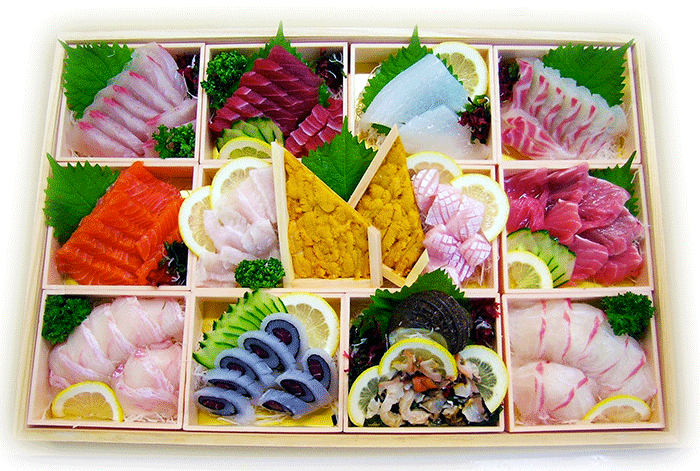
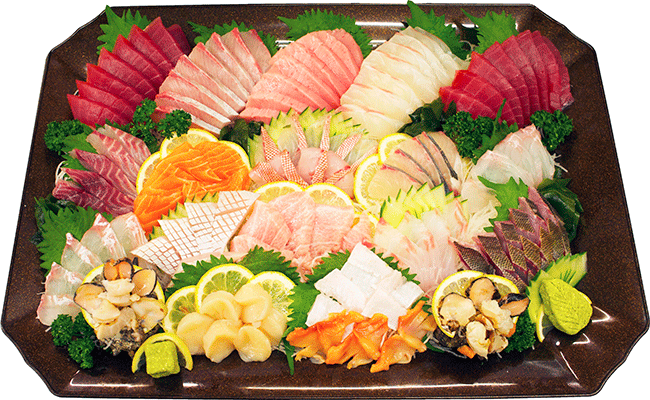
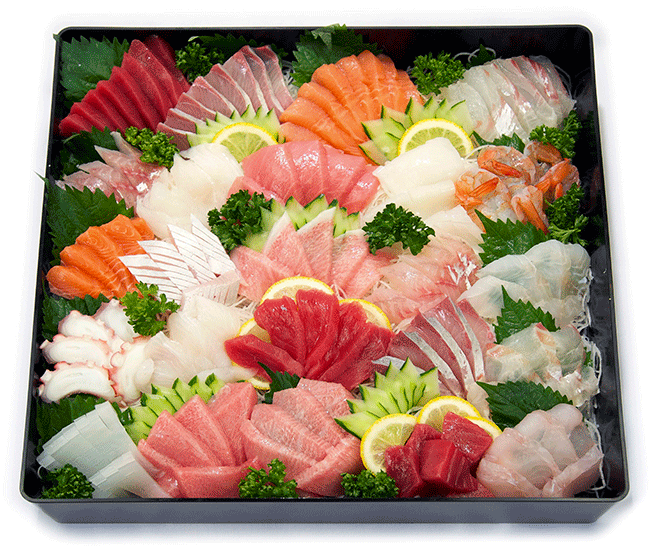
The author has created countless many special ordering dishes of assorted sashimi so far, basically when it is a product of 3,000 yen or more, a container for offering sashimi is also an important factor to increase its product value . Even if it is 5,000 yen instead of 10,000 yen, assuming a scene of a meal where special ordering dishes of assorted sashimi is needed, such a scene because it should be a festive seat or location correct the dignity the special ordering dishes of assorted sashimi should be good looking in a fine container.
However, there are also voices that "it is not necessary to put it in such a high priced, good container" as an opinion. The containers for plastic special ordering dishes of assorted sashimi that I recommend are sometimes 300 yen or 500 yen or even 1,000 yen. It is wasteful to put such a cost on a container that you just throw away after that, and it is too high for the ratio of materials to goods, so there is a view that you do not need something so good.
It seems like "the commentary is a good opinion," but I think it is absolutely wrong.
One thing I would like to mention is not food, but let's consider what an adult male wears. A man who was invited to a certain festive place put a tie on a fine suit with the best clothes appropriate for the occasion, and one case where he appeared in the hall with breezily with the cordovan which was polished to a bright shine. Then another case where the same man appeared in sandals on jeans torn in a T-shirt. Whoever saw him for the first time would think of it as a good person? Even though the human being is exactly the same, depending on the dress, it can be seen as a fine human being, and conversely it can be seen lighter than necessary.
Consider another example of cooking. I think that it is not French food that can be compared with Japanese food in the world. Suppose a person enters a magnificent french restaurant of the grand maison class where a dress code is required. Naturally, although I think that the dishes will be carried in tableware such as Meissen or Royal Copenhagen between the silver forks and knives, it is put in a paper plate for outdoor use. How would you feel when it was carried? Even if the chef explains that everything is the same, will you be willing to pay tens of thousands of full-course fees per person?
Special ordering dishes of assorted products by sashimi and sushi are products that are definitely needed in the non-daily life scene in terms of "Daily life and non-daily life" in human life, so they are suitable for the moment an appearance is required. It is not something that customers who live every day are normally used to, but it invests a large amount of money in a product called special ordering dishes several times a year, so It should be that looks good and looks satisfying.
Sashimi's markup ratio strategy
So what about prices? It is usually the case that customers can not judge whether the content is high or cheap for special ordering dishes of assorted sashimi. In short, it is important how much content you like is at a price commensurate with your budget, and as a result it becomes the most important point whether your satisfaction after eating is high or low, and that is the next point It will be whether it leads to the purchase.
In other words, as a side selling special ordering dishes of assorted sashimi, the price should be developed to fit your budget. For example, there are no major problems if the choice is made with at least a three-step assortment. If that is possible, it will be possible to meet the customer's request by increasing the number of products of the top level and the bottom level up and down by two to create a total of five options.
And finally, the issue of selling price and markup ratio, I also have clear guidelines for this. The idea is that "special ordered dishes of assorted sashimi products have a loss ratio of zero, so they are good at the same level of markup ratio as gross profit margin".
Basically, the special ordering dishes of sashimi products are not good for aiming at a very high markup ratio. Since one product is a high-priced product of thousands of yen, if you try to apply a high mark-up ratio with a loss rate, as with other sashimi and sushi products, there is a risk that the cost performance may collapse.
For the instructor, if the special ordering of sushi and sashimi is 10,000 yen, I would recommend selling 10 units with 25% markup ratio rather than selling 5 units with 40% markup ratio. This is because the difference in volume and quality for the material cost is 1,500 yen in the case of the cost of 6,000 yen and 7,500 yen, including the contents of containers and materials, so the satisfaction of the purchased customer is greatly different.
Furthermore, please imagine the scene of the dining table where the pot is served. It is not possible to eat alone with 10,000 yen of the special ordering of dishes and sushi and sashimi alone, and there should be a scene where a large number of close people gather. And it is said that it was a good looking plastic container with good quality and volume cost performance, and it was mistake to ask a high-class Japanese restaurant. Then, if you are a housewife, maybe one of the topics is "Which store did you ask for this? I will do this for the next New Year ..." It can be an advertising tower for stores.
I'm sorry to be proud, but as a result of continuing teaching in a number of companies under such directionality in the consultant life so far, at the time of the New Year business season, the special ordering of the sushi and sashimi have created many prosperity shops, not one or two, that can not meet the customers' orders.
There are shops where such expensive special ordering of dishes and sushi and sashimi are in such a situation that they have too many orders from customers and work capacity is exceeded, and some of them are forced to refuse orders. In this case, it is not necessary to compete with nearby competitors for price competition, and daily sales will continue to grow constantly.
Let's make prosperity shop by increasing repeaters
In this month's issue, I think that some people might have thought that the theme of blue fusilier was replaced with sashimi, but in fact, using blue fusilier as the intention of the author from the beginning, I thought that I wanted to argue "What is the product of sashimi?".
Sashimi is one of the professional worlds that amateurs can not easily imitate. Anyone can do it until you see it and try to cut sashimi, but it's not easy to combine it with fish and add ashirai to make it attractive for thousands of yen.
In order to be able to successfully manufacture the expensive special ordering dishes of sushi and sashimi, it takes some training time and many manufacturing opportunities. Companies that have many such experiences become more and more strong, and companies with few such opportunities are no longer able to compete, and customers can not be selected as a sashimi purchase shop and fall out.
It is not easy for the expensive special ordering items of sushi and sashimi to sell more and more. It can not be done in a year or two, and it will build up the customer's evaluation of the special ordering dishes of sushi and sashimi products while spending at least five or ten years. But as a result of years of effort, if the high reputation from customers is established, there is nothing scary after that. Not only the special ordering dishes of assorted sashimi but also the other products will receive high evaluations, and overall sales will not fall.
Not late yet. If you want to reign as a steadfast store in five years and ten years ahead, you have to find out what you really want, without being concerned about efficiency, rationalization, or labor saving. It is good for customers to buy it and it is delicious and how to make it a store where repeaters will be added again by saying "I want to buy again", and taking special ordering of the assorted sashimi as one specific example, I want you to think firmly from various viewpoints.
| Please access the following URL if you want to secure using SSL. All pages in the site will be secure pages. |
| https://secure02.blue.shared-server.net/www.fish-food.co.jp/message english 5.2019.html |
An opinion and the communication are to iinfo@fish food times
Date of updating 1 May. 2019
